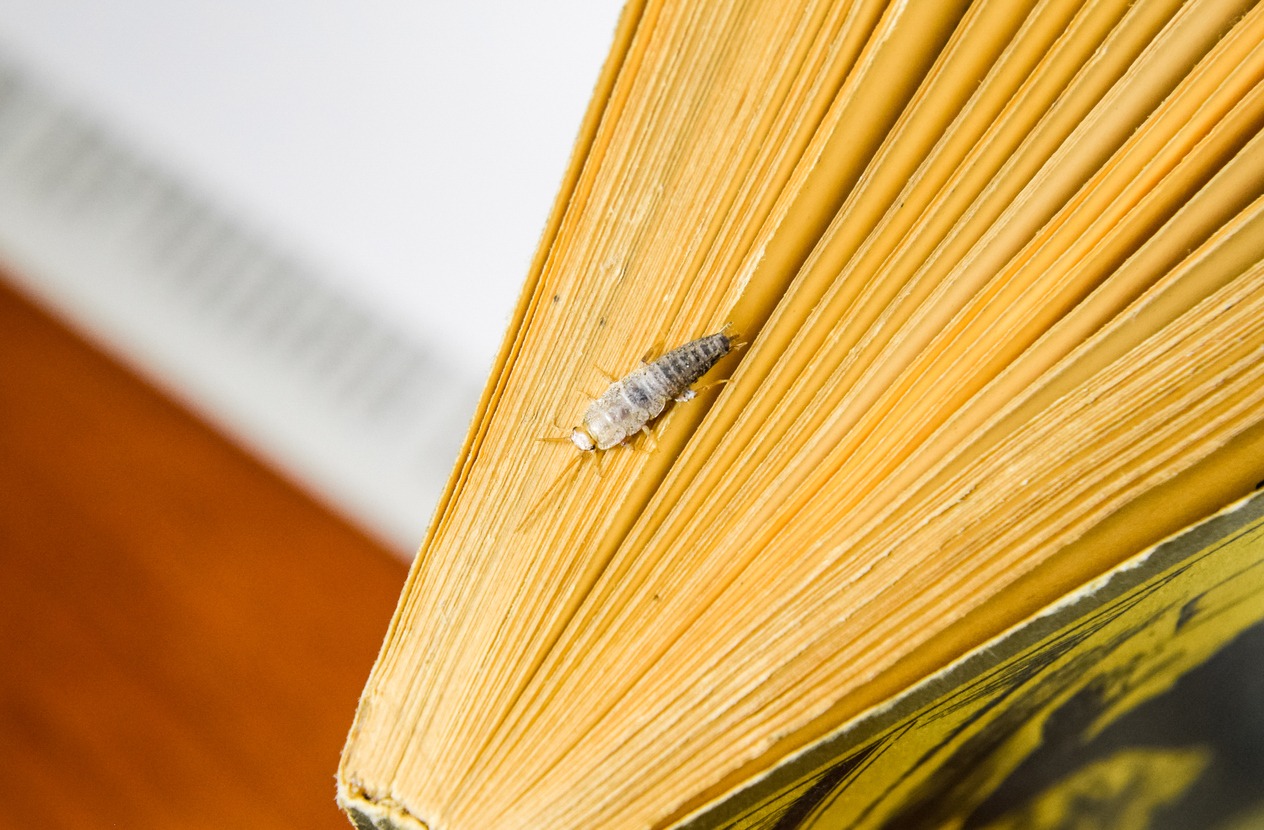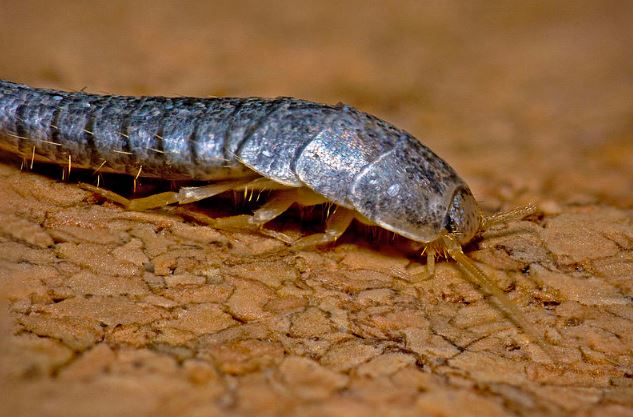If you’ve recently noticed small silver bugs crawling around your house, chances are they are silverfish. And you may be wondering how these creepy crawlies got into your house. While these insects can be frustrating, the good news is there are lots of things you can do to try to banish their presence.
What are Silverfish?
Silverfish (Lepisma saccharina) are not fishes – they are one of the most common pest insects in the world. They are small, nocturnal, and voracious insects who love foods that are high in starches. These insects are silver or gray in color, and their bodies are covered in tiny scales, hence the name. They move like fishes, thanks to their tapered tails and antennas. They can move quickly, so they can often outrun predators.
They love paper and can eat through boxes, books, and wallpaper. Dust, dandruff, hair, and dust can also be food sources for silverfish, along with clothing, glue, cotton, silk, and linen. These insects can also eat dried beef products, coffee, sugar, and foods high in carbs, such as rolled oats and flour.
Silverfish are about ½” to 1” long and can live as long as eight years. They are rarely seen during the daytime since they are nocturnal.
What Attracts Silverfish?
If you have a silverfish infestation in your home, you’re probably wondering where these bugs came from. Here are the things that can attract silverfish to your house:
Moisture
Like other household pests, silverfish thrive in moist and humid environments. They live in moist, well-protected areas like under rocks and logs or in leaf litter in their natural habitats. However, in a household environment, they tend to live near sinks, in basements, bathrooms, laundry rooms, or attics. These bugs can also appear in bedrooms. If you want to know more about the causes of silverfish bugs infesting beds and bedrooms, you can read our article, What Causes Silverfish Bugs On The Bed?
Food sources
Like all insects, this pest needs to eat. These bugs rely on starchy food sources like paper, fibers, fabrics, sugars, grains, pasta, and dried goods. They eat composting plant material, leaves, and other decomposing items in their natural environment. They will happily munch on food scraps, stray pieces of pet food, and dried goods like cereal, sugar, and flour inside a house.
Places to hide
Silverfish love to hide themselves in protected areas, like behind bookshelves, behind furniture, or in damp basements.
Places to lay eggs
Safe, moist corners are where they like to lay eggs. They often do so in dark, moist, and hidden areas of the house. Their eggs are yellow or white and bulb-shaped.
Signs of Silverfish Infestation
Do you think you might have silverfish in your house? Here are some tell-tale signs to look for:
1. Droppings
Silverfish have unique-looking droppings. It looks like small, black peppercorns and is usually found in areas silverfish like to frequent, like the space beneath cupboards or the backs of furniture. These droppings are usually small enough that many people mistake them for dust or household debris. If you sweep it once and it keeps reappearing, it’s a sign that you have a pest problem.
2. Yellow stains on clothing and paper products
If you see yellow stains showing up in your books, papers, cardboard boxes, wallpaper, or clothes, it can be a sign that silverfish has traveled on them. Sometimes, these stains are accompanied by small holes and droppings.
3. Skin molts
Throughout their lives, silverfish can shed their skins. Their outer shells are delicate, small, and transparent. Seeing them is a good indication of a silverfish infestation.
4. Damage to belongings
If you see holes or damage to your linens, wallpaper, clothing, or cardboard, it’s a sign that they are present. Look for holes chewed through items like this.
5. Actually seeing silverfish
You can be 100% sure that there’s a silverfish infestation in your home once you see one or a couple of them. These small, flexible, slippery insects can wiggle back and forth as they move. Spotting them is a bit hard because they are nocturnal. But seeing even just one is a good indication that your house is infested with these pests somewhere.
Are Silverfish Dangerous?
Silverfish are harmless to humans and animals. They don’t bite, sting, or carry diseases – hence, they’re not much of a threat. However, they are still unpleasant to live with because they can cause damage to your belongings, like books, old papers, carpets, wallpapers, and clothes.
If you notice small holes in your books or clothes, along with yellow staining, it can be a sign that your house has been infested with silverfish. They also love to hide in unsealed pasta, cereal, and oat packets, so you will need to get rid of them, causing you to waste food.
Also, some people with severe allergy symptoms may experience reactions to the skin molts or feces of silverfish.
Are Silverfish a Sign of a Dirty House?
You might be wondering if the presence of silverfish in your home is a sign that your house is dirty. It’s a common myth, but the truth is that starfish are not drawn to dirty homes. Instead, silverfish love moisture and their presence is more of an indicator of excess moisture rather than dirtiness in a home. Since silverfish can eat common construction and building materials, even clean homes can offer them sustenance.
It might also suggest that there’s an entry point in your home caused by water damage, like a leak that allows rainwater in.
Silverfish also see dusty areas of the house as a smorgasbord. Since dust is usually made of organic residues like dander and human skin, silverfish can also survive on dust alone.
When silverfish die or become injured, the living silverfish feed on the carcasses to fulfill their protein needs.
Home Remedies to Get Rid of Silverfish
If you have silverfish in your home, here are some ways to get rid of them naturally:
1. Glass container traps
Try to create your own silverfish traps using a glass container filled with some flour, dried cereal, or pet food. Silverfish love these foods, so they will go to great lengths just to seek them out. Leave the top off the glass container and wrap the outside surface with tape. Silverfish can get inside the jar using the textured surface of the tape. However, they won’t be able to get back out because their feet can’t get traction on the smooth surface of the glass. In short, the silverfish will be trapped inside.
2. Newspaper
Wet an old newspaper, roll it up, and put it in a hidden area of your house. Silverfish can crawl into it and make it their home. After a few days, throw away the newspaper in a sealed, airtight container. You can also choose to burn it to eliminate the silverfish that stays inside.
3. Sticky traps
Sticky traps are usually available at hardware or home and garden stores. These are an excellent way to get rid of silverfish. Place these traps anywhere you’ve noticed silverfish activity. After a few days, check the traps and throw them away. However, sticky traps may not be ideal if you have kids or pets at home.
4. Cedar oil
Cedar oil can be an effective pest killer for silverfish, carpet beetles, and clothes moths. Use an oil diffuser or a spray bottle filled with cedar oil and water for best results. Spray the mixture into problematic areas. Silverfish hate the strong-smelling pheromones in cedar.
Alternatively, you can put cedar shavings in the infected areas. It will be a little bit messy, but it can be vacuumed and replaced every week.
5. Dried bay leaves
Grab a few dried bay leaves from your pantry and place them anywhere you’ve seen silverfish, or in the places, they are likely frequenting. The oils repel silverfish in these leaves, which are proven to be a powerful pest deterrent.
6. Borax
Borax is a salt of boric acid that’s highly toxic to insects, including silverfish. This can help you get rid of them in a matter of days. Spread a thin layer of borax on the back of your cabinets, beneath your appliances, and in other areas where you’ve seen silverfish. Alternatively, you can mix borax with sugar, so it can act as bait as silverfish can’t resist anything sugary.
7. Cinnamon
Same as cedar, humans may love the smell of cinnamon, but silverfish are repulsed by it. Put some ground cinnamon, cinnamon sticks, or cinnamon oil in affected areas to keep these pests away.
8. Cloves
Dried cloves come with eugenol that can repel silverfish. This compound comes with a powerful aroma which these insects don’t like. Put them in infected areas to keep silverfish away.
9. Lemon and other citrus fruits
Another repelling scent for silverfish is citrus scents of lemon and orange. You can place citrus peels around your home to keep these insects at bay. Alternatively, you can make a citrus spray using lemon juice and water. Spray the areas infested.
10. Salt
Silverfish can be attracted to salt, but once they eat it, they will become dehydrated and die. Salt can also absorb dampness in an area.
11. Boric acid
For a harsher substance than salt, go for boric acid. It’s poisonous and toxic to many insects. It can dehydrate them, which leads to their death. It can be mixed with water and used as a spray for affected areas. Since boric acid can be harmful, it’s best to dilute it for the safety of your family and pets.
Conventional Methods to Getting Rid of Silverfish
If silverfish infestation in your home is pretty serious and home remedies won’t cut it, here are a few conventional methods you can try to eradicate them:
1. Poison
Poison is an effective method for controlling silverfish. Silverfish can be wiped away through various pest control methods like all insects. Targeted sprays, foggers, and bombs are all effective options for coping with a silverfish infestation.
But since exposure to these products is toxic and dangerous even to humans and pets, it’s best to limit their use and consider it after all other safer solutions fail. Also, you must never DIY these methods for your own safety. Instead, hire a skilled pest control professional that can service you in your home.
2. Traps
Store-bought traps can help you get rid of silverfish. Like poison control methods, these must be used with caution and never be used in areas with small children or pets.




